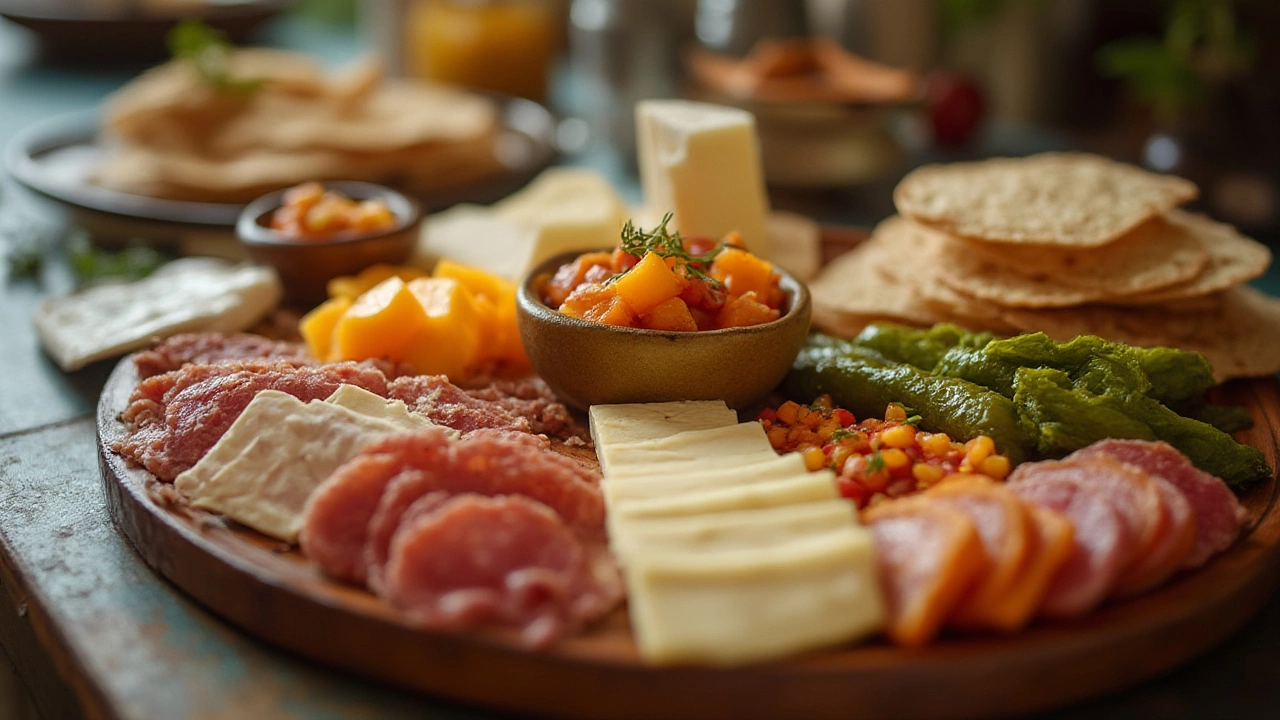
You’ve probably watched friends fuss for ages over charcuterie boards, debating everything from cheese to the last pickle. But secretly, most of us just want to know: is there a simple way to nail these boards every time? Turns out, yes—the 3-3-3 rule for charcuterie boards keeps things both easy and impressive. Whether you’re hosting in a tiny city flat or prepping for a garden party, this rule takes out the guesswork and dials up the wow factor.
How the 3-3-3 Rule Works
The 3-3-3 rule breaks down a charcuterie board into three must-have categories: three cheeses, three meats, and three extras. It’s not a law, but it’s basically the secret handshake of the grazing platter world. Want variety that won’t overwhelm you or your guests? This is it. Each section—cheeses, meats, and extras—gets its starring trio, and you can tailor those picks to your season, budget, or crowd.
Let’s start with cheese. Three is magic because you can hit a soft, a hard, and a blue or funky one without overdoing it. For example, pick something creamy like Brie, a sharp cheddar, and then go bold with a blue Stilton. That trio stands up well to almost any meat or cracker you throw at it.
Then, the meats. Same formula, different flavors. Something cured (think prosciutto or Parma ham), something a bit spicy like chorizo, and one crowd-pleaser, like salami. With those options, every preference gets covered—from traditionalists to those who flirt with a little heat.
Now, the extras. This is where you add fruit, nuts, pickles, or spreads for pops of color, texture, or tartness. Grapes, salted almonds, and a punchy chutney or olive tapenade hit all the right notes. And don’t overlook local twists—here in Edinburgh, adding oatcakes or Scottish heather honey can bring a lovely personal touch.
The 3-3-3 rule creates instant balance. It even works for different board sizes. If you’re planning a huge party, just add multiples of three. Smaller gathering? Stick to the basics and nail the ratios. You can also swap items in each category—no need to panic if you can’t find Manchego at your local shop. Simplicity meets flexibility, and that’s why people love it.
Why Balance Matters (and How to Nail It)
There’s a science to why boards with variety feel more satisfying. When you give people options, you’re not just catering to different tastes—you are awakening all sorts of cravings: salty, savory, creamy, crunchy, sweet, and even bitter. If you look at data shared by the British Cheese Board in 2024, 78% of guests reported enjoying cheese platters more when given at least three distinct types of cheese. That extra choice fires up their sense of discovery, not just their tastebuds.
This mix is especially key if you’ve got vegetarians or guests with dietary quirks. With the 3-3-3 rule, it’s easy to swap a cured meat for a pile of roasted veg or a vegan cheese without the board looking sparse. Invite the gluten-free friend? Use rice crackers or add more fruit. No one gets left out, and the board still looks full and thoughtful.
There’s another reason to mix things up—visual appeal. Boards that have different shapes, colors, and heights are just more exciting (and way more Instagrammable). Place rolled meats next to stacked cubes of hard cheese. Tuck a few whole sprigs of rosemary near shiny olives for contrast. Even a simple drizzle of honey can catch the light and make the plate look lavish.
This balance also extends to flavor pairings. If you’re lost, a quick tip: salty cheeses like pecorino pop alongside sweet things like figs. Spicy meats mellow if you serve them with creamy brie or mild hummus. Strong blue cheese? Break up that intensity with sliced pears or a spoonful of honey. Small moves deliver big payoffs.

How to Pick Ingredients Like a Pro
After years of building boards, I’ve learned that the best platters aren’t about expensive cuts or rare cheeses—they're about smart choices. If you start with the 3-3-3 backbone, picking ingredients gets much less overwhelming. For cheeses, I usually choose one local variety, one classic, and one with a bit of funk. In Scotland, that might mean an Isle of Mull cheddar, Brie de Meaux, and a wedge of Blue Murder.
For meats, freshness and sliceability matter most. If you buy from a deli, ask them to slice meats thin, which makes layering and rolling easy. Continental favorites like prosciutto and salami are safe bets, but don’t be afraid to try bresaola or even beef pastrami. If you want to go vegetarian, grilled aubergine strips or lightly charred peppers slot right in.
The extras give you space to get creative. Fresh fruit like figs, cherries, or apple slices are seasonal and bright. Add nuts, such as hazelnuts or spiced cashews, for crunch. For spreads, I make my own herby whipped feta—takes five minutes, tastes like something from a fancy café. Pickled onions or cornichons are stars if your meats are salty and rich. And if you want bonus points, hunt down those Scottish oatcakes or Highland marmalade for a little local pride.
Don’t overlook the bland spots! Crackers are important—mix up thin water biscuits with seeded crisps. If you’re serving wine, think about how each category pairs: soft cheese with sparkling, hard cheese with reds, and blue cheese if you want to bust out a dessert wine. Your board suddenly becomes a conversation starter, not just background nibbles.
Presentation Tricks to Make Your Board Stand Out
No one likes a beige, limp board. You don’t have to be an artist, but there are clever cheats for a wow effect. Odd numbers catch the eye, so place items in clusters of three or five. Roll the meats, fan out cheese wedges, and group extras so the platter looks full but not crowded. Big piles in the centre, small groups on the edges, with little gaps for dipping or picking.
A huge win: room-temperature cheese. Pull everything out at least half an hour before guests arrive; flavour and texture improve massively. I learned the hard way that ice-cold brie is a no-go. For meats, space them out, so oils don’t run and flavours stay distinct. Fruit can be left whole for people to grab, or sliced for easy sharing—just squeeze a little lemon on apples or pears so they don’t brown.
Want it to look like you spent hours, even if you didn’t? Add in-fills: whole herbs, edible flowers, or even festive berries if it’s a winter party. Place crackers in loose stacks or ‘rivers’ that wind around the cheese and meat. Drizzle honey over blue cheese or camembert to make it glisten. Tiny bowls for chutneys or olives keep mess at bay and make the board pop in photos.
If you’re feeling precise, here’s a simple table showing how much to buy for different gathering sizes:
| Guests | Cheese (g) | Meat (g) | Extras (g) |
|---|---|---|---|
| 2-4 | 250 | 200 | 150 |
| 6-8 | 400 | 350 | 250 |
| 10+ | 700+ | 600+ | 400+ |
Remember, the board is meant to spark laughs, stories, and sampling—not fill everyone up before dinner. Keep it finger-friendly; don’t chunk things too large. And always have plenty of napkins nearby, especially if you go big on sticky jams or oily meats.

Mixing It Up: When to Break the 3-3-3 Rule
Here’s something that surprises most: the 3-3-3 rule is a starter, not a strict rulebook. Got vegans or non-pork eaters coming? Toss in a fourth ‘extra’ section with roasted veg, falafels, or smoked nuts. Is it a wine night? Add dark chocolate squares or dried fruits for that luxurious touch. For breakfast parties (trust me, they’re a thing in Edinburgh after Hogmanay!), some people swap meats for smoked salmon, scrambled eggs, or even breakfast pastries for a new twist.
Holidays and big celebrations are perfect for adding on. At Christmas, I always sneak in cranberry compote, mulled wine jellies, or gingerbread biscuits. In summer, stone fruits and young goat’s cheese switch up the flavour game. Following the rule loosely means your board always feels fresh, not formulaic.
If you’re short on cash, don’t stress. Go with one or two cheeses, one meat, and fill with extras. Quality matters more than quantity. A beautifully ripe camembert and a pile of fresh bread is sometimes all you need. On the flipside, if you’re celebrating, scale it up—actual Edinburgh cheese tastings often feature five, six, or even more varieties to encourage sampling and debate. The 3-3-3 rule acts as a flexible springboard, not a fence.
Try involving your guests too. Let them build their own bites or vote on their favourite combo. It sparks banter and turns everyone into a charcuterie fan. And don’t stress if the board gets messy fast; that just means you nailed it.
So next time you crack open the cheese fridge and wonder where to begin, remember the 3-3-3 rule. Three cheeses, three meats, three extras—it’s simple, smart, and never fails to impress. And if you feel playful, tweak it to fit the moment. Because grazing, snacking, and chatting is what boards are all about.





Categories